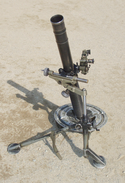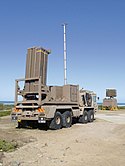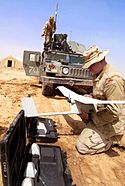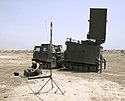Lyncanestrian Army
This article is incomplete because it is pending further input from participants, or it is a work-in-progress by one author. Please comment on this article's talk page to share your input, comments and questions. Note: To contribute to this article, you may need to seek help from the author(s) of this page. |
Template:Infobox Military Unit The Imperial Lyncanestrian Army is the land component of the Lyncanestrian Armed Forces. It is the largest and oldest component of the Latin Armed Forces, with some 288,000 active and 53,000 reserve personnel in its order of battle. It is oriented towards defending Lynanestria’s territorial integrity against potential Liothidian aggression, as well as collective security obligations towards the wider Belisarian Community. The Lyncanestrian Army is primarily manned by personnel undergoing a two-year period of compulsory national service, and officered by well-trained professionals.
Higher Organisation
At the strategic level, the Lyncanestrian Army consists of the I, II, and III Army Corps, the Territorial Defence Commands and the Capital Garrison Command.
Corps, divisions and brigades
Each of the three Army Corps have at their disposal three divisions: one armoured and two mechanised, as well as an airborne brigade. They are primarily responsible for the defence of Lyncanestria in high-intensity warfare against a Liothidian incursion.
An armoured division ('Division Blindee') is comprised of three primary maneouvre elements, in the form of combined arms brigade groups. An armoured division has two armoured and mechanised brigades. A mechanised division ('Division Mecanisee') reverses this ratio, with one armoured and two mechanised brigades. Brigades are formed of 'regiments' which, in Lyncanestria, are the equivalent of battalions in foreign armies.
An armoured brigade consists of two armoured regiments (56 tanks each in four squadrons), an mechanised infantry regiment (around 800 troops), a reconnaissance regiment (56 scout cars), an artillery regiment (24 self-propelled howitzers in three batteries), an air defence company (12 self-propelled anti-air vehicles in four platoons) and a logistics regiment. The brigade totals around 4,500 personnel.
A mechanised brigade is organised on similar lines, but with one armoured and two mechanised regiments instead.
Aside from these brigades, each division also possesses twelve independent regiments: rocket artillery, combat engineer, air defence, attack helicopter, medical, heavy transport, logistics, maintenance, signal/electronic warfare and CRBN defence. These are organised under the division’s combat support group.
Aside from the divisions, each army corps also possesses an airborne brigade ('Brigade Parachutiste'). This is a highly-trained light infantry formation, intended to support the corps' heavy forces in rough or urban terrain, in which heavy mechanised forces are at a disadvantage. Although trained in parachute operations, it is envisaged that they will primarily operate as a corps' rapid airmobile reserve, deploying from helicopters. Each brigade consists of three airborne battalions, a pathfinder company, a heavy mortar regiment, an air defence company and a logistics regiment.
Territorial Forces Commands and the Capital Garrison Command
The Territorial Forces Commands provide regional garrisons for the empire’s territory. They are essentially a militia force, comprised of part-time civilian volunteers who, by virtue of the fact that they would have previously served in the regular army, possess a level of military training. Their primary purpose is the defence of the regular army’s operational rear area from Liothidian paratroopers, special forces or saboteurs. Those militia units positioned near the border would also be tasked with safeguarding Lyncanestrian sovereignty against ‘hybrid warfare’ scenarios.
In total, the Territorial forces can generate up to 13 brigades. Each Territorial Brigade is manned at roughly 10%-30% level in peacetime, and rapidly reinforced with reservists upon mobilisation. Each consists of 3-4 light infantry regiments, a heavy mortar regiment, an air defence company, and a logistics regiment.
The Imperial Guards Brigade is a formation of light mechanised infantry consisting of seven regiments: the 1st-5th Grenadier Guards, the Horse Guards Dragoons, the Guards Mounted Artillery. It is tasked with protecting the person of the emperor and the imperial family. In times of war or public emergency, it garrisons the capital city in conjunction with a local Territorial Force brigade.
Special forces
The Lyncanestrian Army's special forces contingent consists of a brigade of five Parachute Ranger Regiments ('Régiment de Chasseurs Parachutiste', usually abbreviated as the 'RCP'.), of which the 1e Regiment is at full strength in peacetime, and the other four are partially comprised of reservists. They are highly trained specialists in a variety of direct action, unconventional warfare and counter-terrorism/special forces scenarios.
In the event of conventional warfare against Liothidia, the 2nd-5th Regiments would be charged with operating in the zones of the four army corps. They would primarily be responsible for acting as 'stay-behind' observation posts behind enemy lines, identifying high-priority targets and directing air or missile attacks against them. They would also gather intelligence, stage raids, and organise partisan forces in occupied territory.
Small unit organisation
The regiment is the army’s basic tactical unit. It is the equivalent of a 'battalion' in other armies, comprising of between 6-800 personnel.
A regiment consists of three to four companies. An armoured regiment possesses four squadrons, each with fourteen tanks, plus an additional two at the regimental headquarters. An infantry regiment consists of three rifle companies and a manoeuvre support company. The latter is the repository of the regiment’s mortar platoon (eight 120mm tubes), reconnaissance platoon and anti-tank platoon (24x missile launch units).
The infantry company is divided into three platoons. Each platoon has 42 personnel, transported by four infantry fighting vehicles. It is led by a 2nd lieutenant, who is assisted by a platoon sergeant and a radioman, plus 12 vehicle crew and 27 riflemen in three squads. Each squad is split into two four-men fireteams centred around a light machine gun, plus a squad leader.
Equipment
Small arms
| Name | Image | Origin | Type | Cartridge | Details |
|---|---|---|---|---|---|
| P01 | 
|
Pistol | 9×19mm | ||
| BS-08 | 
|
Sub-machinegun | 9×19mm | To be phased out in favour of the MPX | |
| MPX | File:SIG SAUR MPX.jpg | Sub-machinegun | 9×19mm | ||
| BR-055 Assault Rifle | Assault rifle | 5.56x45 | Former main service rifle. Currently being phased out. | ||
| F516 | Assault rifle | 5.56x45mm | Standard issue rifle from 2010 | ||
| FP6 | Shotgun | 12 Gauge Shotgun | |||
| BR-55M | 
|
Semi-automatic sniper rifle / Designated marksman rifle | 5.56x45mm/7.62×51mm | ||
| F500 | File:Barrett XM500.jpg | Anti-materiel rifle | 12.7x99mm | ||
| MG4 | Light machine gun | 5.56×45mm | Replacing the MG710 as the standard squad machine gun | ||
| MG3 | 
|
Medium Machine gun | 7.62×51mm | ||
| M2 HB | 
|
Heavy machine gun | 12.7×99mm |
Grenade-based weapons
| Name | Image | Origin | Type | Details | |
|---|---|---|---|---|---|
| L109A1 | 
|
Grenade | |||
| M203 grenade launcher | 
|
Under-barrel grenade launcher | 40mm | ||
| GL09 Advanced Airburst Weapon | File:Advanced airburst weapon 2.png | Handheld automatic grenade launcher | 25mm grenades | ||
| SB LAG 40 | 
|
Automatic grenade launcher | 40mm |
Anti-tank weapons
| Name | Image | Origin | Type | Details |
|---|---|---|---|---|
| Crossbow | Shoulder-launched anti-tank weapon | |||
| MBT LAW | 
|
Shoulder-launched anti-tank weapon | ||
| BGM-71 TOW | 
|
Anti-tank guided missile | To be phased out | |
| Vesper missile | Anti-tank guided missile | Currently being produced to become standard issue | ||
| Polyphem | Loitering missile | |||
| Scorpion missile | 
|
Heavy ATGM for helicopters and UAV's |
Combat vehicles
| Name | Image | Origin | Type | Numbers |
|---|---|---|---|---|
| BMS Parmenio MBT | Main battle tank | 2,500 | ||
| Cavalier Main Battle Tank | Main battle tank | Mainly in reserve, engineering, bridge-laying and other utility variants still in use | ||
| BMS Harma | 
|
Infantry fighting vehicle | ||
| AIFV | 
|
Infantry fighting vehicle | A Lyncanestrian adaptation of the Belfrasian Testudo. Currently being phased out. | |
| Testudo | 
|
Common armoured vehicle platform | Mainly used in support roles | |
| BMS Weasel AFV | 
|
Armoured scout vehicle | ||
| Apollo Motors Battleaxe | 
|
General utility vehicle | ||
| Dingo | 
|
MRAP |
Artillery
| Name | Image | Origin | Type | Numbers |
|---|---|---|---|---|
| L16 81mm mortar | 
|
Medium mortar | ||
| M1064 mortar carrier | 
|
120mm self-propelled mortar | Main regimental-level weapon, equipped with RT F1 rifled mortars | |
| RT F1 | 
|
120mm rifled mortar | Main artillery weapon of the light infantry units | |
| Artillery Gun Module | 
|
155mm Self-propelled howitzer | 600+ | |
| M109 howitzer | 
|
155mm Self-propelled howitzer | Obsolete, mostly in storage | |
| TDI Ares | File:MLRS 05.jpg | Self-propelled rocket artillery | 100 |
Air Defence Weapons
| Name | Image | Origin | Type | Numbers |
|---|---|---|---|---|
| GDF | 
|
Template:Country data Nekor | 35mm twin AA gun | |
| SIDAM 25 | 
|
Quad 25mm self-propelled AA gun | Largely phased out in favour of the Harma SHORAD variant | |
| FIM-92 Stinger | 
|
MANPAD | ||
| Rapier (missile) | 
|
Short-range SAM system | Former main division-level anti-air weapon. Now mainly relegated to the static defence of airfields and secondary assets | |
| AD-16 Adder | 
|
Short- to medium-range SAM system | Current main Division-level anti-air weapon | |
| AD-12 Area Defence Missile | Long-range SAM system | Used to defend high-value static and semi-static assets |
Army Aviation
| Name | Image | Origin | Type | Numbers |
|---|---|---|---|---|
| Fennec | 
|
Light utility/scout helicopter | ||
| A129 | 
|
Attack helicopter | ||
| AW101 | 
|
Medium-lift helicopter | ||
| Aigios Heron | 
|
Heavy-lift helicopter | ||
| AeroVironment RQ-11 Raven | 
|
Miniature UAV | ||
| Falco | 
|
Medium UAV | ||
| MQ-1C Warrior | 
|
Long-endurance UCAV |
Battlefield surveillance
| Name | Image | Origin | Type | Numbers |
|---|---|---|---|---|
| Mobile Artillery Monitoring Battlefield Radar | 
|
Counter-battery radar | ||
| RASIT | 
|
Battlefield surveillance radar | ||
| Giraffe radar | 
|
Battlefield air defence radar |
